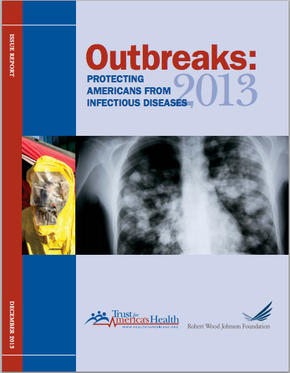By Paul Etkind, DrPH, MPH, Senior Director of Infectious Diseases, NACCHO
In the middle of the 20th century, vaccines and antibiotics were having spectacular successes in preventing and controlling infectious diseases. Numbers of cases were declining rapidly, and medical and public health professionals were soberly predicting the elimination of infectious diseases from this world. On a personal note, when I was accepted to my MPH program in the mid-1970s, I was advised to focus on heart disease or cancer, because I was earnestly told that infectious diseases would be, at best, an academic and professional backwater of the public health profession. (True story.)
What a difference a few decades make. Infectious diseases are back, and pose more significant dangers to the health and well-being of the entire world than ever before. Trends such as antibiotic resistance; increases in healthcare associated infections linked with increasingly complex medical technologies; global climate change resulting in expanded ranges of arthropod (i.e. insect) disease vectors; massive population movements across international borders; increasing human movement into areas that have had little history of settlement; an increasingly global commerce and food chain; and, an erosion of the public health system are all contributing to phenomena called emerging (i.e.newly recognized) infectious diseases and re-emerging diseases (i.e. diseases thought to have been “conquered”).
 America’s ability to prevent and control such diseases was placed under the microscope by Trust for America’s Health (TFAH) and Robert Wood Johnson Foundation (RWJF) in the recent report, “Outbreaks: Protecting Americans from Infectious Disease,” and the picture their investigation has developed is not reassuring. They saw and documented that America’s ability to prevent and control infectious disease cases and outbreaks is being hampered by outdated information systems, inadequate technologies, and limited resources available to fix the problems.
America’s ability to prevent and control such diseases was placed under the microscope by Trust for America’s Health (TFAH) and Robert Wood Johnson Foundation (RWJF) in the recent report, “Outbreaks: Protecting Americans from Infectious Disease,” and the picture their investigation has developed is not reassuring. They saw and documented that America’s ability to prevent and control infectious disease cases and outbreaks is being hampered by outdated information systems, inadequate technologies, and limited resources available to fix the problems.
Some examples of findings from the report include the following:
- Healthcare associated infections, which infect one of every 20 people hospitalized, are not reportable in one-third of the states;
- Although influenza affects at least one of every five Americans each year, only one-quarter of states vaccinated at least half of their populations; and,
- One-third of states do not cover routine HIV screening in their Medicaid programs, while almost one in five infected Americans do not know they are infected.
Since 2008, 43,900 local health department jobs have been eliminated due to budget cuts. As local health departments continue to face shrinking budgets and diminished capacity due to a weak economy and budget pressures on federal, state, and local governments, these cuts are undermining their present work and impeding innovation. Of particular concern for America and the public health profession is the lack of policy maker and public support for critical public health infrastructure. A few examples of issues that directly affect the ability of local health departments to prepare for and respond to outbreaks include the following:
- Decreased capacity for surveillance, which enables the government to identify and monitor emerging diseases and outbreaks; to assess the success (or not) of prevention and control measures; and, to assess the level of risk of various diseases by looking at and measuring “upstream” reasons for disease incidence;
- Decreased staff with the ability to conduct investigations;
- Lack of staff with the technical expertise to work with complex data systems and advanced computing capacities;
- Lack of access to laboratories with highly trained staff using current, sophisticated technologies and equipment that can do testing crucial for case and outbreak investigations as well as screening activities;
- Decreased staff who understand the complexities of effective health communication using a variety of social and traditional media to promote behaviors that decrease risk of infection;
- Lack of up-to-date policies to protect critical resources such as food, water and air; and,
- Lack of seamless coordination with medical care providers and institutions.
Local health departments are a critical part of any community’s first response to disease outbreaks. Being able to have these capacities takes resources and policies that prioritize education and training programs with up-to-date tools and technologies; expanding on the extent to which Americans are fully and appropriately immunized; treatment and prophylactic policies and practices that prevent continued increases in antibiotic resistance; improved health education and promotion strategies that can help lead people to more healthy and disease preventing behaviors; and, increasing the American population’s resilience to counter the effects of global climate instability, pandemics, and other disasters and emergencies that will have health implications and encourage the spread of infectious diseases.
Public health is not a just-in-time service or profession. The public and community leaders cannot expect to just “flick a switch” in the event of a problem or an emergency and assume the public health enterprise will step up and deliver. TFAH and RWJF have done an admirable job of showing how much needs to happen in the background and as part of on-going efforts if we are to be more fully protected from the significant and sometimes frightening effects of infectious diseases.
About Paul Etkind
Paul Etkind is the Senior Director for Infectious Diseases at NACCHO. His work includes oversight of the Epidemiology, HIV/STI, Immunization and Infectious Disease projects, as well as coordinating those with Emergency Preparedness, Environmental Health, Food Safety, and Disability initiatives. Email: [email protected]









